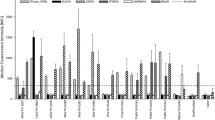Abstract
Two methods for the detection of Cucumber vein yellowing virus (CVYV) on infected plants were developed, based on the information provided by cDNA clones covering the 3′-end of the genome of a Spanish isolate (CVYV-AILM). The sequenced portion of the CVYV-AILM genome showed a 96.6% aminoacid identity with that of a reported sequence of another CVYV isolate from Israel (Lecoq et al., 2000). The first detection method used a RNA specific probe for hybridization with nucleic acids extracted from infected plants. The probe was complementary to a portion of the CVYV genome including the C-terminal part of the NIb and most of the coat protein (CP) coding regions. The second detection method employed polyclonal antisera raised against recombinant viral CP expressed in bacteria. The specific antibodies were used to detect the presence of virus particles in plant extracts. Both procedures resulted in a highly specific detection of CVYV in plants infected with different isolates of the virus. No interference was observed with other cucurbit-infecting viruses. Sensitivities achieved were sufficient for routine diagnosis of the presence of the virus in plants.
Similar content being viewed by others
References
Aguilar JM, Franco M, Marco CF, Berdiales B, Rodriguez-Cerezo E, Truniger V and Aranda MA (2003)Further variability within the genus Crinivirus, as revealed by determination of the complete RNA genome sequence of Cucurbit yellow stunting disorder virus. Journal of General Virology 84:2555-2564.
Andersen K and Johansen IE (1998)A single conserved amino acid in the coat protein gene of pea seed-borne mosaic potyvirus modulates the ability of the virus to move systemically in Chenopodium quinoa. Virology 241:304-311.
Andrejeva J, Puurand U, Merits A, Rabenstein L, Jarvekulg L and Valkonen JP (1999)Potyvirus helper component-pro-teinase and coat protein (CP)have coordinated functions in virus-host interactions and the same CP motif affects virus transmission and accumulation. Journal of General Virology 80:1133-1139.
Celix A, Lopez-Sese A, Almarza N, Gomez-Guillamon ML, Rodriguez-Cerezo E (1996)Characterization of Cucurbit Yellow Stunting Disorder Virus, a Bemisia tabaci-transmited closterovirus. Phytopathology 86:1370-1376.
Clark MF and Adams AN (1977)Characteristics of the microplate method of enzyme-linked immunosorbent assay for the detection of plant viruses. Journal of General Virology 34:475-483.
Cuadrado IM, Janssen D, Velasco L, Ruiz L and Segundo E (2001a)First report of Cucumber vein yellowing virus in Spain. Plant Disease 85:336.
Cuadrado IM, Velasco L and Janssen D (2001b)CVYV detection-using RT-PCR. European Whitefly Studies Network, John Innes Centre, Norwich Research Park, Colney Lane, Norwich NR4 7UH United Kingdom (http:// www.white.y.org).
Dolja VV, Haldeman R, Robertson NL, Dougherty WG and Carrington JC (1994)Distint functions of capsid protein in assembly and movement of Tobacco etch potyvirus in plants. EMBO Journal 13:1482-1491.
Garcia JA, Fernandez-Fernandez MR and Lopez-Moya JJ (1998)Proteinases involved in plant virus genome expression. In:Dunn BM (ed.)Proteases of Infectious Agents (pp 233-263). Academic Press, New York, USA.
Janssen D, Ruiz L, Velasco L, Segundo E and Cuadrado IM (2002)Non-cucurbitaceous weed species shown to be natural hosts of Cucumber vein yellowing virus in south eastern Spain. Plant Pathology 51:797.
Jones DR (2003)Plant viruses transmitted by whiteflies. European Journal of Plant Pathology 109:195-219.
Lecoq H, Desbiez C, Delecolle B, Cohen S and Mansour A (2000)Cytological and molecular evidence that the white. y-transmitted Cucumber vein yellowing virus is a tentative member of the family Potyviridae. Journal of General Virology 81:2289-2293.
Lopez-Moya JJ and Pirone TP (1998)Charge changes near the N terminus of the coat protein of two potyviruses a. ect virus movement. Journal of General Virology 79:161-165.
Lopez-Moya JJ, Wang RY and Pirone TP (1999)Context of the coat protein DAG motif a. ects potyvirus transmissibility by aphids. Journal of General Virology 80:3281-3288.
Luis-Arteaga M, Alvarez JM, Alonso-Prados JL, Bernal JJ, Garcia-Arenal F, Laviña A, Batlle A and Moriones E (1998) Occurrence, distribution, and relative incidence of mosaic viruses infecting eld-grown melon in Spain. Plant Disease 82:979-982.
Mansour A and Musa AA (1993)Cucumber vein yellowing virus:Host range and virus vector relationships. Journal of Phytopathology 137:73-78.
Marco CF, Aguilar JM, Abad J, Gomez-Guillamon ML and Aranda MA (2003)Melon resistance to Cucurbit yellow stunting disorder virus is characterized by restricted virus accumulation. Phytopathology 93:844-852.
Mas P and Pallas V (1995)Nonisotopic tissue-printing hybrid-ization-A new technique to study long-distance plant-virus movement. Journal of Virological Methods 52:317-326.
Pirone TP and Blanc S (1996)Helper-dependent vector transmission of plant viruses. Annual Review of Phytopathology 34:227-247.
Rubio L, Janssen D, Cuadrado IM, Moreno P and Guerri J (2003)Rapid detection of cucumber vein yellowing virus by tissue-print hybridisation with digoxigenin-labelled cDNA probes. Journal of Virological Methods 114:105-107.
Sambrook J and Russell DW (2001)Molecular cloning-A laboratory manual, 3rd ed. Cold Spring Harbor Laboratory Press, Cold Spring Harbor, New York, USA.
Sela I, Assouline I, Tanne E, Cohen S and Marco S (1980) Isolation and characterization of a rod-shaped, whitefly-transmissible, DNA-containing plant virus. Phytopathology 70:226-228.
Sevik MA and Arli-Sokmen (2003)Viruses infecting cucurbits in Samsun, Turkey. Plant Disease 87:341-344.
Shukla DD, Ward CW and Brunt AA (1994)The Potyviridae. CAB International, Oxon, United Kingdom.
Towbin H, Staehelin T and Gordon J (1979)Electrophoretic transfer of proteins from polyacrylamide gels to nitrocellulose sheets:Procedures and some applications. Proceedings of the National Academy of Sciences, USA 76:4350-4354.
Author information
Authors and Affiliations
Rights and permissions
About this article
Cite this article
Martínez-garcía, B., Marco, C., Goytia, E. et al. Development and use of detection methods specific for Cucumber vein yellowing virus (CVYV). European Journal of Plant Pathology 110, 811–821 (2004). https://doi.org/10.1007/s10658-004-2491-7
Issue Date:
DOI: https://doi.org/10.1007/s10658-004-2491-7




